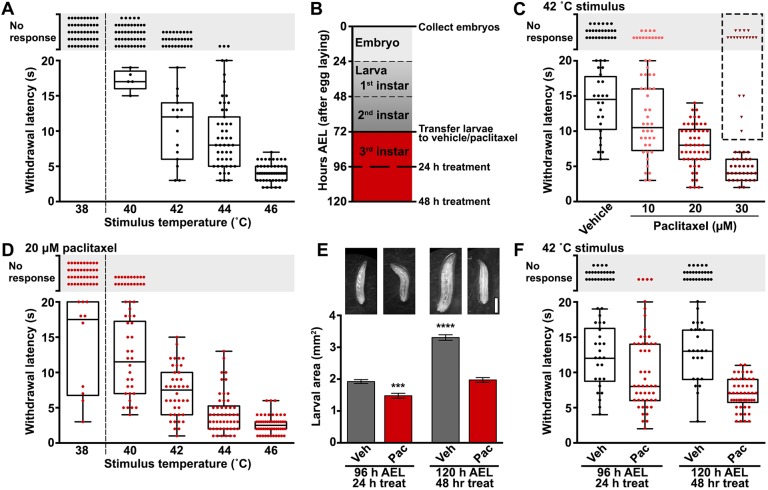Fig. 1.
Novel model of paclitaxel-induced sensory dysfunction using Drosophila larvae. (A) Thermal nociceptive profile of third instar larvae (120 h AEL) stimulated at the indicated temperatures. Each data point represents an individual larva scored for withdrawal latency (box and whiskers) or categorized as no response if aversive withdrawal was not initiated within 20 s of stimulation. No larvae responded at 38°C, indicating sub-threshold stimulation (dashed line). Larvae were transferred to vehicle-laced food at 72 h AEL. n=50 larvae tested at each temperature. (B) Paclitaxel treatment paradigm outlining the time course of treatment during larval development. Larvae were age matched during embryo collection, transferred to treatment at early third instar (72 h AEL) and treated for either 24 h or 48 h before testing for thermal nociception or neuropathy at 96 h AEL or 120 h AEL, respectively, during late third instar. (C) Withdrawal response from 42°C stimulation of late third instar (120 h AEL) larvae after 48 h exposure to either vehicle (0.2% DMSO) or 10 µM, 20 µM or 30 µM paclitaxel. Each data point represents an individual larva. Upon 48 h exposure to 30 µM paclitaxel, several larvae exhibited motor disturbances (triangles) and were excluded from calculation of the withdrawal latency (box and whisker). A concentration of 20 µM was selected as being optimal for engendering thermal nociceptive hypersensitivity and is used in the remainder of this study. n=50 larvae tested for each treatment condition. (D) Thermal nociceptive profile of 120 h AEL larvae subjected to 48 h paclitaxel treatment stimulated at the indicated temperatures. Paclitaxel-induced hypersensitivity is robustly detected at 42°C stimulation by both an increased response rate of the larvae tested and a decrease in the withdrawal latency of responders compared to vehicle-treated controls (panel A) and is used in the remainder of this study. n=50 larvae tested at each temperature in conjunction with vehicle-treated controls in A. (E) Representative images of larvae at age 96 h AEL and 120 h AEL treated with either vehicle (Veh) or 20 µM paclitaxel (Pac) for 24 h or 48 h, respectively, acquired from a dissection microscope fitted with a smartphone adapter. Scale bar: 1 mm. Larval area is presented in mm2 and is derived from the length multiplied by the width of each larva. Mean±s.e.m.; one-way ANOVA with Tukey's multiple comparisons test. (F) Thermal nociceptive withdrawal behavior upon 42°C stimulation tested over the time course of treatment. The withdrawal behavior is maintained from 96 h AEL to 120 h AEL during larval development of vehicle-treated controls. Paclitaxel-induces nociceptive hypersensitivity that progresses with the duration of treatment from 24 h and 48 h treatment. n=50 larvae at each time point and treatment. ***P<0.001, ****P<0.0001.

